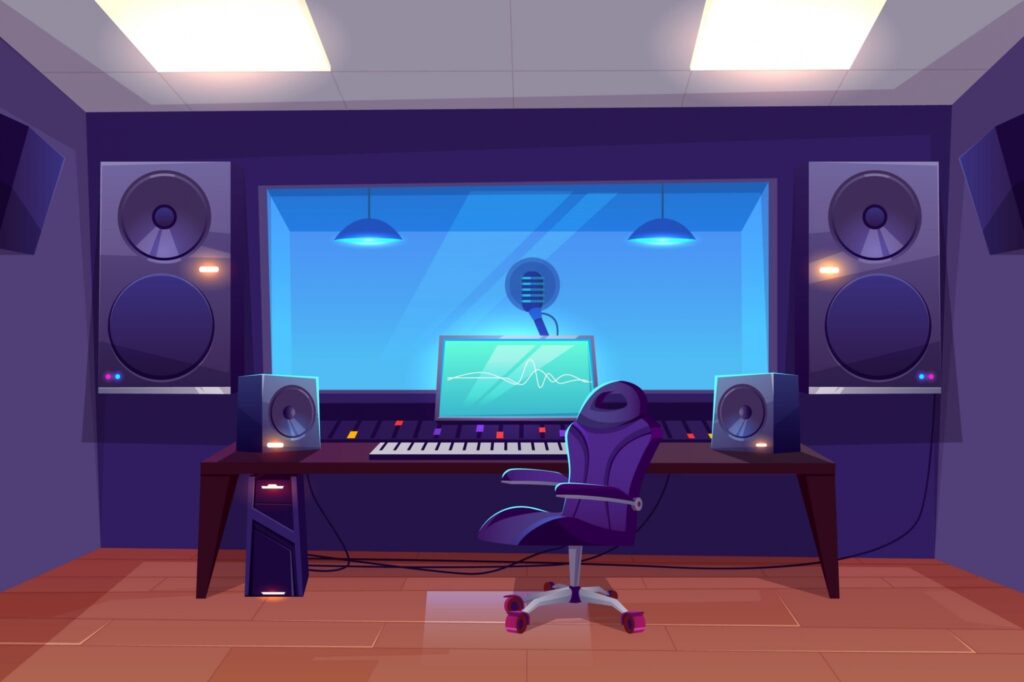Setting up a home recording studio can be a fun and rewarding project. You can create your own music, voice-overs, audiobooks and more with the right equipment and software. Here are some steps to help you get started:
- Choose the right room. You want a room that is large enough to fit your equipment and has good acoustics. Avoid rooms that are too small, too square, or have too many windows. A carpeted floor and a solid wood door can help reduce unwanted noise and reflections1234
- Soundproof your room. You can use acoustic foam, bass traps, or fabric to absorb and diffuse sound waves. This will improve the quality of your recordings and prevent sound leakage. You can also use curtains, rugs, or furniture to block out external noise sources1234
- Choose a desk and a chair. You need a comfortable and ergonomic workspace to operate your computer and other devices. Make sure your desk is large enough to accommodate your monitor, keyboard, mouse, audio interface, and MIDI controller. Your chair should support your back and allow you to adjust your height and posture1234
- Choose a computer. Your computer is the heart of your home recording studio. It will run your digital audio workstation (DAW) software and store your audio files. You need a computer that has enough processing power, memory, storage space, and ports to handle your recording needs. You can use either a Mac or a PC, depending on your preference and budget1234
- Choose a DAW. Your DAW is the software that allows you to record, edit, mix, and master your audio tracks. There are many options available, such as Pro Tools, Logic Pro X, Cubase, Ableton Live, Digital Performer, and Reason. Some are more expensive than others, but they all have similar features and functions. You can also use free programs like GarageBand (Mac only), Sonar Cakewalk (Windows only), or Audacity (both)1234
- Choose an audio interface. Your audio interface is the device that converts analog signals from your microphones and instruments into digital signals that your computer can process. It also converts digital signals from your computer into analog signals that you can hear through your speakers or headphones. You need an audio interface that has enough inputs and outputs for your recording setup, as well as good sound quality and low latency. Some popular brands are Focusrite, Presonus, M-Audio, Behringer, and Steinberg1234
- Choose a microphone, a pop shield, and a stand. Your microphone is the device that captures the sound of your voice or instrument. You need a microphone that suits your recording purpose and style. There are two main types of microphones: dynamic and condenser. Dynamic microphones are more durable and less sensitive to background noise, but they have less frequency range and detail than condenser microphones. Condenser microphones are more fragile and require phantom power, but they have more clarity and accuracy than dynamic microphones. A pop shield is a filter that prevents plosive sounds (such as “p” or “b”) from distorting your recordings. A stand is a support that holds your microphone in place and allows you to adjust its position and angle. Some common microphone models are Shure SM57 (dynamic), Shure SM58 (dynamic), Rode NT1-A (condenser), Audio-Technica AT2020 (condenser), and Blue Yeti (USB)1234
- Choose studio monitors or headphones. Studio monitors are speakers that deliver a flat and neutral sound for mixing and mastering your audio tracks. They are different from regular speakers that may enhance or color the sound in some way. You need studio monitors that have enough power and frequency range for your room size and acoustics. You also need to place them correctly in relation to your listening position and the walls of your room. Some popular brands are KRK, Yamaha, JBL, Mackie, and Adam Audio.1234 Headphones are another option for monitoring your audio tracks. They are more affordable and portable than studio monitors, but they may not give you the same spatial awareness and accuracy as speakers. You need headphones that have good sound quality, comfort, isolation, and durability. There are two main types of headphones: open-back and closed-back. Open-back headphones have a more natural and spacious sound, but they leak sound to the outside and let in ambient noise. Closed-back headphones have a more isolated and focused sound, but they may cause ear fatigue and distortion. Some popular models are Sennheiser HD 280 Pro (closed-back), Beyerdynamic DT 770 Pro (closed-back), AKG K240 (open-back), and Audio-Technica ATH-M50x (closed-back)1234
- Choose audio cables. Audio cables are the wires that connect your devices and transfer sound signals. You need audio cables that are compatible with your equipment and have good quality and durability. There are different types of audio cables, such as XLR, TRS, TS, RCA, and USB. You need to know the difference between balanced and unbalanced cables, as well as the difference between analog and digital cables. Balanced cables have three wires that cancel out noise and interference, while unbalanced cables have two wires that are more prone to noise and interference. Analog cables carry analog signals that vary in voltage and frequency, while digital cables carry digital signals that consist of binary data1234
I hope this helps you set up your home recording studio. If you need more information or inspiration, feel free to email us to provide you with solutions.

